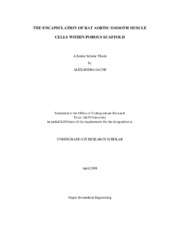| dc.description.abstract | Growing rat aortic smooth muscle cells (RASMC) in vitro has posed numerous difficulties in the past. Smooth muscle cells are known to need a three-dimensional (3-D) structure, neighboring cells, space to allow for elongation and media to encourage normal behavior. Current technology in polymers presents a potential means to create a 3-D porous environment that mimics the natural habitat for RASMC. Through this experiment various methods have been employed to produce the optimal structure for the cells. Cells are encapsulated in rapidly degrading polyethylene glycol (PEG) bead-shaped gels. These beads are then encapsulated in a cross-linked PEG rectangular scaffold. In time, the beads degrade while the cells remain intact. In essence, this allows for the creation of open pores in which the cells remain. The cells then have the chance to elongate and assume natural shape and behavior. The method proposed has shown successfully that upon the beads’ degradation, the cells remain intact within the PEG hydrogel scaffold. | en |


